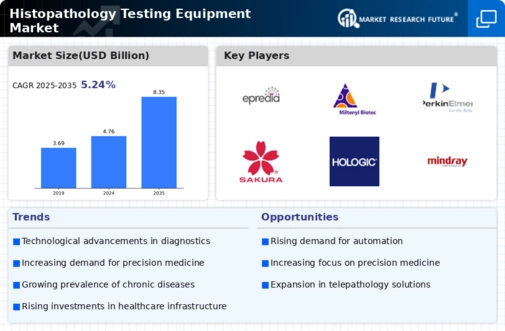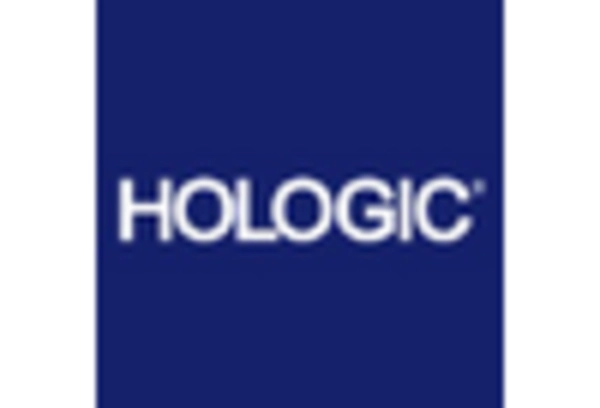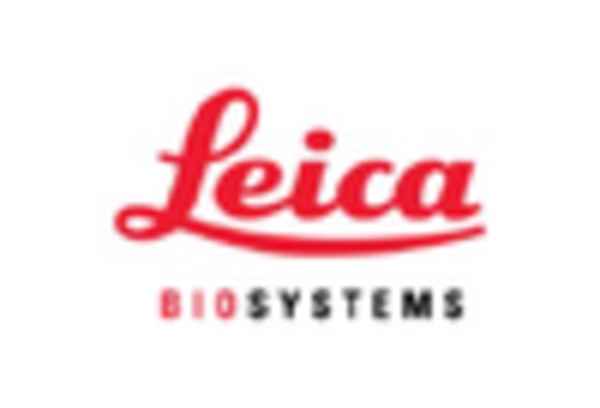Increasing Incidence of Cancer
The rising incidence of cancer globally is a pivotal driver for the Histopathology Testing Equipment Market. As cancer rates continue to escalate, the need for accurate and timely diagnosis becomes paramount. Histopathology plays a crucial role in cancer diagnosis, guiding treatment decisions and patient management. Recent statistics indicate that cancer cases are expected to rise by approximately 70% over the next two decades, necessitating enhanced histopathological services. This growing demand for histopathology testing is propelling the market forward, as healthcare providers seek to equip their facilities with state-of-the-art testing equipment. Consequently, the Histopathology Testing Equipment Market is poised for significant expansion, driven by the urgent need for effective cancer diagnostics.
Expansion of Healthcare Infrastructure
The expansion of healthcare infrastructure in various regions is a crucial driver for the Histopathology Testing Equipment Market. As countries invest in improving their healthcare systems, there is a corresponding increase in the establishment of diagnostic laboratories and medical facilities. This expansion necessitates the procurement of advanced histopathology testing equipment to ensure high-quality diagnostic services. Recent reports suggest that healthcare expenditure is projected to rise significantly, with many nations prioritizing the enhancement of laboratory services. This trend is expected to create a favorable environment for the Histopathology Testing Equipment Market, as more healthcare providers seek to upgrade their equipment to meet the growing demand for histopathological testing.
Rising Focus on Research and Development
The Histopathology Testing Equipment Market is significantly influenced by the increasing focus on research and development within the healthcare sector. As medical research advances, there is a growing need for sophisticated histopathology equipment to support various studies, including drug development and disease pathology. Investment in R&D is expected to rise, with many institutions allocating substantial budgets to enhance their histopathological capabilities. This trend is likely to foster innovation in testing equipment, leading to the introduction of more advanced and efficient tools. Furthermore, collaborations between academic institutions and industry players are anticipated to drive the development of novel histopathology solutions, thereby propelling the Histopathology Testing Equipment Market forward.
Growing Awareness of Early Disease Detection
The increasing awareness surrounding the importance of early disease detection is a significant driver for the Histopathology Testing Equipment Market. As healthcare systems emphasize preventive care, the demand for histopathological testing is on the rise. Early diagnosis of diseases, particularly cancers, can lead to better treatment outcomes and improved patient survival rates. Public health campaigns and educational initiatives are contributing to this heightened awareness, encouraging individuals to seek timely medical evaluations. Consequently, healthcare providers are investing in advanced histopathology testing equipment to meet this growing demand. This trend is likely to stimulate growth within the Histopathology Testing Equipment Market, as more facilities aim to enhance their diagnostic capabilities.
Technological Innovations in Histopathology Testing Equipment
The Histopathology Testing Equipment Market is experiencing a surge in technological innovations, which are enhancing the accuracy and efficiency of diagnostic processes. Advanced imaging techniques, such as digital pathology and artificial intelligence, are being integrated into histopathology equipment, allowing for more precise analysis of tissue samples. This shift towards automation and digitalization is not only streamlining workflows but also improving diagnostic outcomes. According to recent data, the adoption of digital pathology solutions is projected to grow at a compound annual growth rate of over 10% in the coming years. As laboratories increasingly invest in these advanced technologies, the Histopathology Testing Equipment Market is likely to witness substantial growth, driven by the demand for improved diagnostic capabilities.

















Leave a Comment